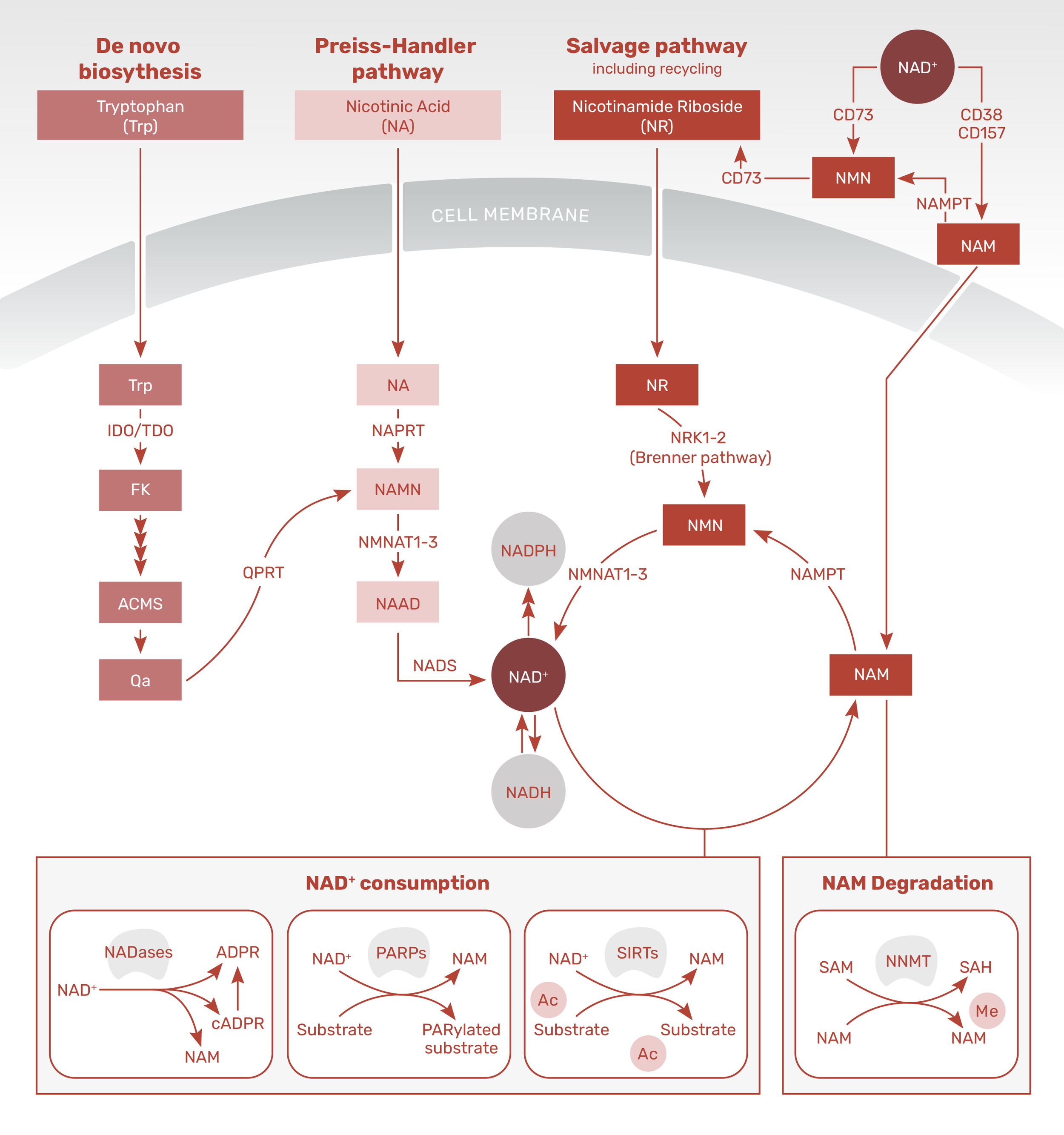What is the NAD Metabolome?
The NAD Biosynthesis Pathways
Biosynthesis is the creation of complex molecules within living organisms or cells. NAD can be synthesized from a variety of different dietary sources which naturally contain tryptophan (Trp), nicotinic acid (NA), nicotinamide (NAM), nicotinamide riboside (NR), or NAD itself. These nutrients get transported across the gut wall, to be distributed to the various cells and tissues. These dietary sources and precursors, such as NR, can be consumed as supplements to further synthesize NAD. Depending on the bioavailability of the precursors, there are three different pathways the body uses to generate NAD – the de novo pathway (which uses Trp), the Preiss–Handler pathway (utilizes NA), and the salvage pathway (utilizes NAM, NR & nicotinamide mononucleotide, NMN) [1].
FIGURE 1. CONSUMPTION AND BIOSYNTHESIS OF NAD Figure adapted from Fang, E.F., et al., NAD(+) in Aging: Molecular Mechanisms and Translational Implications.Trends Mol Med, 2017. 23(10): p. 899-916.
In a healthy state, NAD is efficiently recycled within the body, [2] however, when NAD levels are depleted, there is a great need to replenish cellular NAD. The de novo and Preiss-Handler pathways are considered inefficient and (relatively) high energy consuming pathways when NAD is depleted [2, 3]. This helps explain why when cells are stressed and energy metabolism is compromised (and NAD depleted), cells respond by down-regulating the genes encoding enzymes involved in these pathways. Similarly, under these conditions, cells will upregulate the genes encoding enzymes in the salvage pathway [4]. The salvage pathway, also known as the nicotinamide riboside kinase (NRK) pathway is less energy consuming and has been shown to be preferential in preclinical studies and muscle cells [5, 6].
The NAD Metabolome
A metabolome is a collection of all of the small molecules that exist in a given chemical pathway, cell, organ, or whole organism. The NAD metabolome (also called the NADome) consists of all of the compounds that are a part of the process to synthesize NAD (specifically, the NAD precursors), the compounds that utilize NAD, and the molecular products resulting from NAD’s breakdown or metabolism [7]. Common components of the NAD metabolome include:
-
NAD+ (of course),
-
nicotinamide adenine dinucleotide hydride (NADH), the reduced form of NAD+,
-
nicotinamide adenine dinucleotide phosphate (NADP+),
-
reduced nicotinamide adenine dinucleotide phosphate (NADPH), and the
-
NAD+ precursors
-
nicotinic acid (NA),
-
nicotinamide (NAM), and
-
nicotinamide riboside (NR),
-
as well as the NR precursor, NMN. Other NADome compounds that are pathway intermediates and/or indicators of NAD+ usage and metabolism include:
-
nicotinic acid adenine dinucleotide (NAAD)
-
N-methyl-nicotinamide (MeNAM)
-
nicotinic acid mononucleotide (NAMN), and
-
adenosine diphosphate ribose (ADPR) [7, 8]
As the science of NAD continues to advance and intrigue scientists, it is likely that we will learn more about the components of the NADome and how they are impacted by various stressors, including poor diet, a lack of sleep, alcohol and drug use and disease. Hopefully, we will also learn how improvements in these areas positively change the NADome and contributor to our overall health and resilience.
References
- Fang, E.F., et al., NAD(+) in Aging: Molecular Mechanisms and Translational Implications. Trends Mol Med, 2017. 23(10): p. 899-916.
- Yang, Y. and A.A. Sauve, NAD(+) metabolism: Bioenergetics, signaling and manipulation for therapy. Biochim Biophys Acta, 2016. 1864(12): p. 1787-1800.
- Yang, T., N.Y. Chan, and A.A. Sauve, Syntheses of nicotinamide riboside and derivatives: effective agents for increasing nicotinamide adenine dinucleotide concentrations in mammalian cells. J Med Chem, 2007. 50(26): p. 6458-61.
- Fletcher, R.S., et al., Nicotinamide riboside kinases display redundancy in mediating nicotinamide mononucleotide and nicotinamide riboside metabolism in skeletal muscle cells. Mol Metab, 2017. 6(8): p. 819-832.
- Trammell, S.A., et al., Nicotinamide riboside is uniquely and orally bioavailable in mice and humans. Nat Commun, 2016. 7: p. 12948.
- Liu, L., et al., Quantitative Analysis of NAD Synthesis-Breakdown Fluxes. Cell Metab, 2018. 27(5): p. 1067-1080 e5.
- Nikiforov, A., V. Kulikova, and M. Ziegler, The human NAD metabolome: Functions, metabolism and compartmentalization. Crit Rev Biochem Mol Biol, 2015. 50(4): p. 284-97.
- Clement, J., et al., The Plasma NAD+ Metabolome is Dysregulated in 'normal' Ageing. Rejuvenation Res, 2018.
